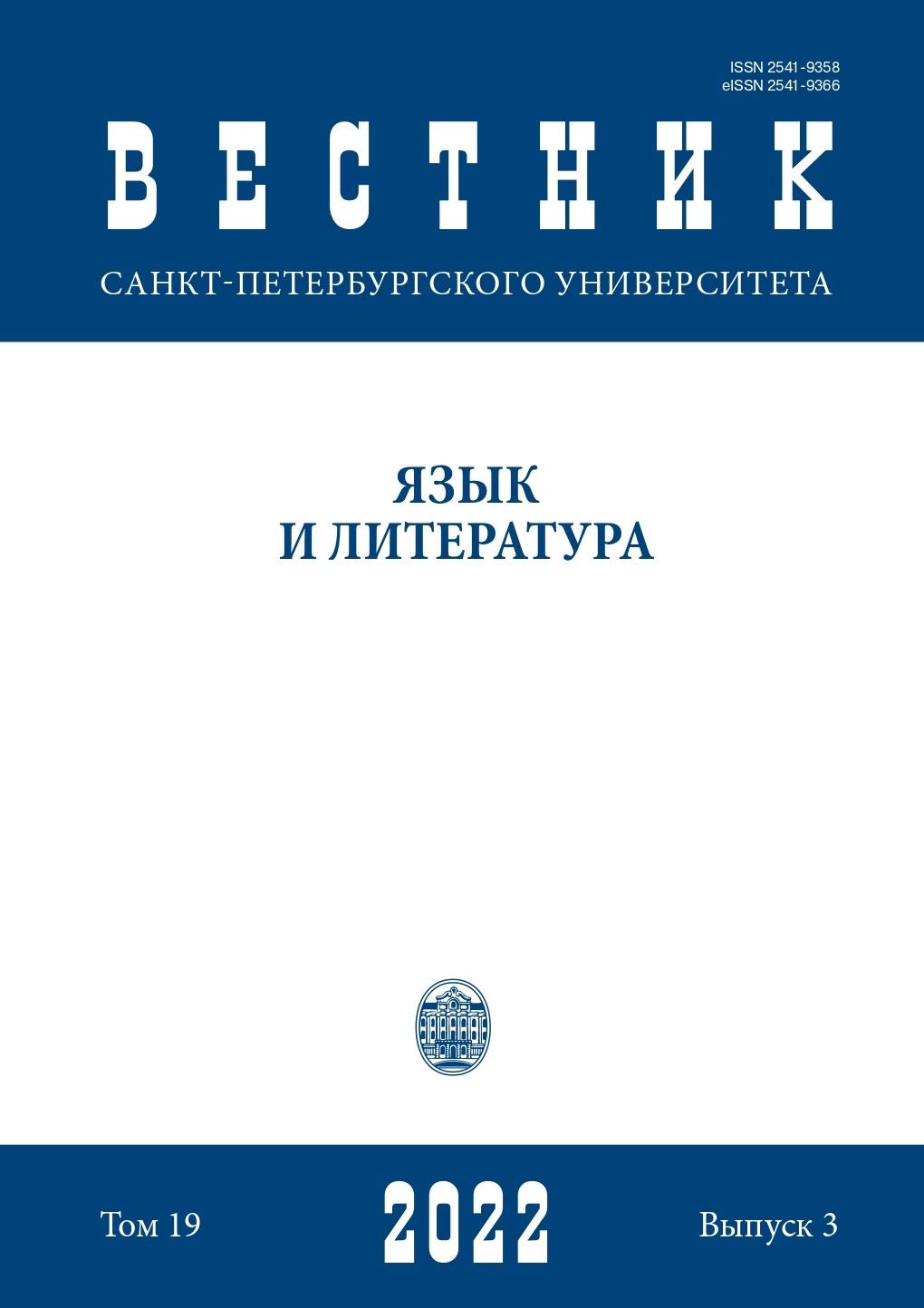Коммуникация 2.0: языковые особенности переписки в мессенджере немецкоязычной молодежи Швейцарии
DOI:
https://doi.org/10.21638/spbu09.2022.314Аннотация
В статье представлены результаты исследования сообщений из переписки в мессенджере WhatsApp, вошедших в корпус проекта швейцарских лингвистов What’s up, Switzerland?, с целью выявления факторов своеобразия и языковых особенностей коммуникации молодежи Швейцарии. В центре внимания находятся основные факторы, определяющие особенности общения молодых пользователей, а именно языковая ситуация диалектно-литературной диглоссии в немецкоязычной Швейцарии, отражение на письме особенностей устной молодежной коммуникации, влияние технологий Web 2.0. Анализ аутентичного материала позволил установить, что повседневное письменное общение молодежи осуществляется преимущественно на диалекте, что соответствует ее стремлению к неформальному и ненормированному общению, а из-за отсутствия четких орфографических правил предоставляет широкие возможности для творческого самовыражения. Наряду с диалектом, который является главной языковой разновидностью и отличительной особенностью повседневного устного и письменного общения в Швейцарии, швейцарская молодежь располагает в письменной коммуникации своим собственным арсеналом языковых средств и приемов для реализации специфически молодежных стратегий и тактик. При общении в мессенджере молодые германошвейцарцы используют разнообразные приемы языковой игры и средства отграничения и «отчуждения» от нормативного языка. Игра с «чужими» языковыми средствами: немецким литературным стандартом, английским языком, этнолектами — чаще всего реализуется при общении в мессенджере по принципу переключения кода или смешения разных языковых форм. К важным результатам анализа относятся выявленные в корпусе многочисленные факты использования новых возможностей и средств цифровой коммуникации 2.0, которые обнаруживаются на фонетико-фонологическом, графическом, лексико-семантическом, морфосинтаксическом и прагматическом уровнях и убедительно демонстрируют все возрастающее влияние медиасреды на язык и характер общения молодого поколения.
Скачивания
Библиографические ссылки
Копчук 2018 — Копчук Л.Б. Проблема языкового стандарта в условиях диглоссии немецкого языка Швейцарии. Филологические науки. Вопросы теории и практики. 2018, 11 (2): 343–350.
Копчук 2021 — Копчук Л.Б. Проявления языковой гибридизации в практиках письменной повседневной коммуникации молодежи немецкоязычной Швейцарии. Вестник Московского государ-ственного лингвистического университета. Гуманитарные науки. 2021, 6 (848): 46–58.
Наседкина 2018 — Наседкина Н.И. Сущность медиатизации как явления современного общества. Universum: Филология и искусствоведение. 2018, 9 (55). https://7universum.com/pdf/philology/9(54)/Nasedkina.pdf (дата обращения: 10.11.2021).
Пивоварчик 2018 — Пивоварчик Т.А. Медиатизация как фактор развития коммуникативной активности личности. В сб.: Корпоративные стратегические коммуникации: новые тренды в профес-
сиональной деятельности: м-лы Второй Междунар. науч.-практ. конф., Минск, 22–23 февраля 2018 г. Минск, 2018. С. 149–152.
Скоблик 2019 — Скоблик О.Н. Теория поколений как инструмент анализа процессов развития и формирования личности. Проблемы современного педагогического образования. 2019, 63 (1): 472–474.
Bucher 2016 — Bucher C. SMS-User als “glocal Player”. Formale und funktionale Eigenschaften von Codeswitching in SMS-Kommunikation. In: Networx. 2016, (73). https://www.mediensprache.net/networx/networx-73.pdf (дата обращения: 10.11.2021).
Christen 2003 — Christen H. Uu fein, welts guet und rüüdig schöön. Überlegungen zu lexikalischen Aspekten eines SchweizerDeutsch der Regionen. In: Dittli B., Häcki Buhofer A., Haas W. (Hrsg.). Gömmer MiGro? Veränderungen und Entwicklungen im heutigen Schweizer Deutschen. Freiburg: Universitätsverlag Freiburg, 2003. S. 25–38.
Dürscheid 2016 — Dürscheid Chr. Neue Dialoge — alte Konzepte? Die schriftliche Kommunikation via Smartphone. Zeitschrift für germanistische Linguistik. 2016, 44 (3): 437–468.
Dürscheid 2003 — Dürscheid Chr. Medienkommunikation im Kontinuum von Mündlichkeit und Schriftlichkeit. In: Theoretische und empirische Problem-Zeitschrift für angewandte Linguistik. 2003, (38): 37–56.
Dürscheid, Spitzmüller 2006 — Dürscheid Chr., Spitzmüller J. Jugendlicher Sprachgebrauch in der Deutschschweiz: eine Zwischenbilanz. In: Dürscheid Chr., Spitzmüller J. (Hrsg.): Zwischentöne. Zur Sprache der Jugend in der Deutschschweiz. Zürich: Verlag Neue Zürcher Zeitung, 2006. S. 13–47.
Hofmann 2018 — Hofmann U. Fragestellungen zur Interaktion von Sprachwandel und Sprachvarietäten. In: Jugendsprachen / Youth Languages: Aktuelle Perspektiven internationaler Forschung / Current Perspectives of International Research. Arne Ziegler A. (Hg.). Berlin; Boston: De Gruyter, 2018. S. 67–84.
Neuland 2008 — Neuland E. Jugendsprache. Eine Einführung. Tübingen: Narr Francke Attempto, 2008.
Strätz 2011 — Strätz E. Sprachverwendung in der Chat-Kommunikation: eine diachrone Untersuchung französischsprachiger Logfiles aus dem Internet Relay Chat (ScriptOralia, 137). Tübingen: Narr Francke Attempto, 2011.
Walther 2018 — Walther D. “Doing Youth” — Zur Erweiterung einer Theorie der Jugendspracheforschung. In: Jugendsprachen / Youth Languages: Aktuelle Perspektiven internationaler Forschung / Current Perspectives of International Research. Arne Ziegler A. (Hg.). Berlin; Boston: De Gruyter, 2018. S. 25–48.
Загрузки
Опубликован
Как цитировать
Выпуск
Раздел
Лицензия
Статьи журнала «Вестник Санкт-Петербургского университета. Язык и литература» находятся в открытом доступе и распространяются в соответствии с условиями Лицензионного Договора с Санкт-Петербургским государственным университетом, который бесплатно предоставляет авторам неограниченное распространение и самостоятельное архивирование.






